2023 Faculty Book Summaries and Covers
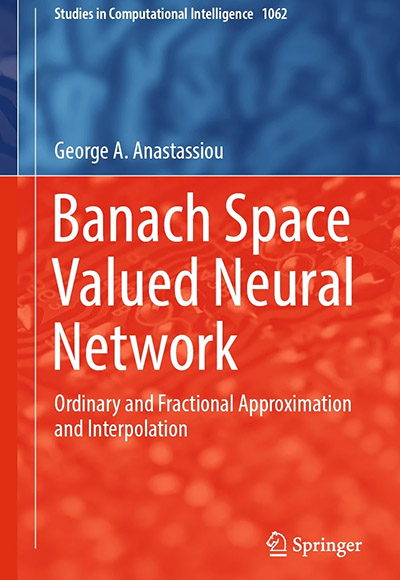 George Anastassiou, Professor, Department of Mathematical Sciences
George Anastassiou, Professor, Department of Mathematical Sciences
Banach Space Valued Neural Network
The book is very useful for researchers, graduate students and educators associated with or interested in recent advances in different aspects of modelling, computational methods and techniques necessary for solving problems arising in the real-world problems. The book includes carefully peer-reviewed research articles presented in the “5th International Conference on Mathematical Modelling, Applied Analysis and Computation”, held at JECRC University, Jaipur, during 4–6 August 2022 concentrating on current advances in mathematical modelling and computation via tools and techniques from mathematics and allied areas. It is focused on papers dealing with necessary theory and methods in a balanced manner and contributes towards solving problems arising in engineering, control systems, networking system, environment science, health science, physical and biological systems, social issues of current interest, etc.
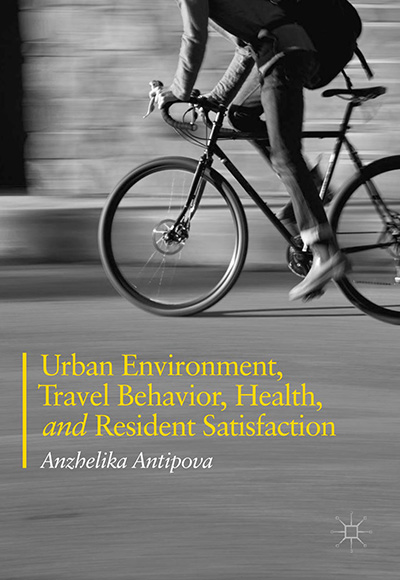 Anzhelika Antipova
Anzhelika Antipova
Urban Environment, Travel Behavior, Health and Resident Satisfaction
This book explores the intersections of urban development, travel patterns, and health. Currently, there is a lack of research concerning the subjective dimensions of accessibility in urban environments and travel behavior, as well as travel-related outcomes. Antipova fills this gap in the scholarship by developing an analysis of satisfaction and perception-related indicators at an intraurban level. Specifically, she investigates various aspects of urban environment from the perspective of resident perception and satisfaction, as well as the relationship between urban environment, travel behavior, activity patterns, and traveler health.
 Shaul Bar, Professor, Holder of the Chair Excellence, Judaic Studies
Shaul Bar, Professor, Holder of the Chair Excellence, Judaic Studies
Here Comes the Dreamer
The Joseph story starts when he was seventeen years old and ends with his death at one hundred and ten. These years included near death experiences, hatred among brothers, jealousy, a bizarre world of dreams, temptation, imprisonment, and his rise to power as grand vizier of Egypt. All of these events led to a change--once an arrogant young man with grandiose dreams, now he became a down to earth man with a sense of humility and a basic sentiment of religion. There was no more hatred among brothers, but love, which led to their eventual reconciliation. Joseph's life as portrayed in the book of Genesis was the starting point of many legends and commentaries found in the Talmud, Midrashim, and medieval commentaries. His behavior was an exemplary prototype of a righteous man; it served as a model for how a person should conduct himself.
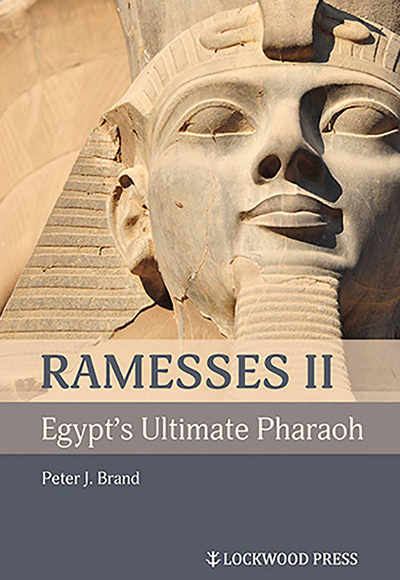 Peter J. Brand, Professor, Department of History
Peter J. Brand, Professor, Department of History
Ramesses II Egypt's Ultimate Pharaoh
Ramesses II was the most magnificent and iconic pharaoh in Egyptian history. His reign was the longest, the most "monumental" in buildings and artwork, the most innovative in diplomacy, and even the most procreative, with over one hundred royal offspring. Drawing on the latest research, Peter J. Brand digs deep into Egyptian culture and archeology, revealing the mindset and motivations of Ramesses II. We find what his grand monuments reveal, and equally what they conceal. On the international scene, we peruse the diplomatic letters--often surprising, sometimes amusing--between Pharaoh and the kings of Babylon, Assyria, and the Hittite Empire. A courageous warrior in his prime, Ramesses was also a wise and visionary statesman. He ended six decades of war with the Hittite Empire by signing the first peace treaty in recorded history. In his later years Ramesses II became a living god, and finally an immortal legend. Forty years after Kenneth Kitchen's Pharaoh Triumphant, here at last is a fresh, engaging look at Ramesses II, Egypt's ultimate Pharaoh.
 Dr. Nicole Detraz, Professor, Department of Political Science, and Director of International
and Global Studies
Dr. Nicole Detraz, Professor, Department of Political Science, and Director of International
and Global Studies
Women and Climate Change
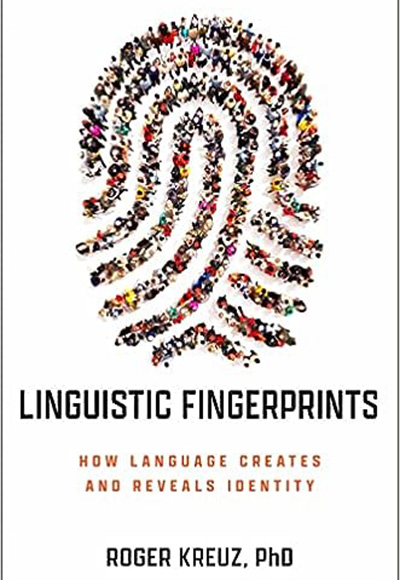 Roger Kreuz, Associate Dean, Professor, Department of Psychology
Roger Kreuz, Associate Dean, Professor, Department of Psychology
Linguistic Fingerprints
How much of ourselves do we disclose when we speak or write? A person’s accent may reveal, for example, whether they hail from Australia, or Ireland, or Mississippi. But it’s not just where we were born—we divulge all sorts of information about ourselves and our identity through language. Level of education, gender, age, and even aspects of our personality can all be reliably determined by our vocabulary and grammar. To those who know what to look for, we give ourselves away every time we open our mouths or tap on a keyboard.
But how unique is a person’s linguistic identity? Can language be used to identify a specific person? To identify—or to exonerate—a murder suspect? To determine who authored a particular book? The answer to all these questions is yes. Forensic and computational linguists have developed methods that allow linguistic fingerprinting to be used in law enforcement. Similar techniques are used by literary scholars to identify the authors of anonymous or contested works of literature. Many people have heard that linguistic analysis helped to catch the Unabomber, or to unmask an anonymous editorialist—but how is it done? LINGUSISTIC FINGERPRINTS will explain how these methods were developed and how they are used to solve forensic and literary mysteries. But these techniques aren’t perfect, and the book will also include some cautionary tales about mistaken linguistic identity.
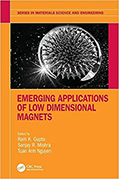 Sanjay Mishra, Professor, Physics and Materials Science
Sanjay Mishra, Professor, Physics and Materials Science
Emerging Applications of Low Dimensional Magnets
Low-dimensional magnetic materials find their wide applications in many areas, including spintronics, memory devices, catalysis, biomedical, sensors, electromagnetic shielding, aerospace, and energy. This book provides a comprehensive discussion on magnetic nanomaterials for emerging applications.
Fundamentals along with applications of low-dimensional magnetic materials in spintronics, catalysis, memory, biomedicals, toxic waste removal, aerospace, telecommunications, batteries, supercapacitors, flexible electronics, and many more are covered in detail to provide a full spectrum of their advanced applications.
This book offers fresh aspects of nanomagnetic materials and innovative directions to scientists, researchers, and students. It will be of particular interest to materials scientists, engineers, physicists, chemists, and researchers in electronic and spintronic industries, and is suitable as a textbook for undergraduate and graduate studies.
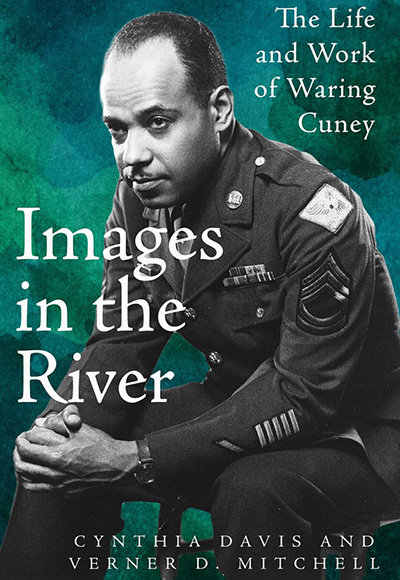 Verner Mitchell, Professor, Department of History
Verner Mitchell, Professor, Department of History
Images in the River
The poet William Waring Cuney (1906-1976) hails from an illustrious Afro-Texan family whose members include the charismatic politician Norris Wright Cuney (1846-1898) and his daughter, Maud Cuney Hare (1874-1936), the concert pianist and writer. Waring Cuney’s maternal line, after whom he was named, was equally eminent.
Cuney was born and raised in Washington D.C., just a few blocks from Howard University where three generations of his family studied. Despite his privileged upbringing among the city’s Black elite, Cuney embraced his family’s passionate commitment to racial uplift and civil rights; in exploring the relationship between African Americans and their environment, he was thus able to transmute into two books of poetry a broad cross section of African American life; his poems and songs explore the lives of jazz musicians, athletes, domestic and railway workers, women and children, blues singers, prisoners, sharecroppers, and soldiers. In addition, Cuney published in all the major Harlem Renaissance journals and anthologies alongside the luminaries of the period, many of whom were good friends.
Through 100 of his best poems, many never collected or published, and a detailed biographical monograph, Images in the River: The Life and Work of Waring Cuney introduces readers to a newly recovered Harlem Renaissance poet, and to the history of a remarkable American family.
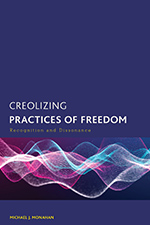 Michael J. Monahan, Professor, Department of Philosophy
Michael J. Monahan, Professor, Department of Philosophy
Creolizing Practices of Freedom
Creolizing Practices of Freedom argues that many of our long-standing debates over the concept of freedom have been bound up in the politics of purity—explicitly or implicitly insisting on clear and distinct boundaries between self and other or between choice and coercion. In this model, freedom becomes a matter of purifying the self at the individual level and the body politic at the larger social level. The appropriate response to this is a creolizing theory of freedom, an approach that sees indeterminacy and ambiguity not as tragic flaws, but as crucial productive elements of the practice of freedom.
Michael J. Monahan is professor of Philosophy at the University of Memphis in Memphis, Tennessee. His teaching and research focus on political philosophy, philosophy of race and racism, Africana philosophy, phenomenology, and Hegel. He is the editor of Creolizing Hegel (2017) and The Creolizing Subject: Race, Reason, and the Politics of Purity (2011).
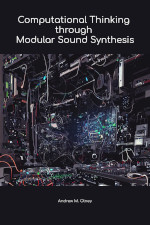 Andrew M. Olney, Professor, Institute for Intelligent Systems
Andrew M. Olney, Professor, Institute for Intelligent Systems
Computational Thinking through Modular Sound Synthesis
This book presents an approach to learning computational thinking without explicit programming within the context of modular sound synthesis. Modular sound synthesis exists at the intersection between music, signal processing, and implicitly, functional programming, since each module represents a function that performs an operation on sound. However, no code is written in the process; rather, “programming” consists of connecting wires between modules to carry audio or control signals. Learning computational thinking through modular combines the strengths of existing approaches that incorporate games and art while avoiding the pitfalls of traditional programming.
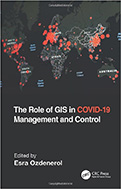 Esra Ozdenerol, Professor, Department of Earth Sciences
Esra Ozdenerol, Professor, Department of Earth Sciences
The Role of GIS in COVID-19 Management and Control
Geographic Information System (GIS) is one of the most important tools to help us understand public health and many aspects of our lives. Because of COVID-19, GIS has been brought into the spotlight more than ever before. People and civic leaders worldwide are turning to maps and real-time surveillance data to make sense of what has been happening in the world and to get answers to important questions on every aspect of this pandemic. This book examines the role of GIS in managing and controlling the spread of COVID-19 through 12 global projects and a multidisciplinary approach. It explains the innovative uses of GIS not only limited to data organization and data access, but also how improved GIS tools are used to make decisions, plan, and communicate various measures of control in both local and full-scale outbreaks during the COVID-19 pandemic.
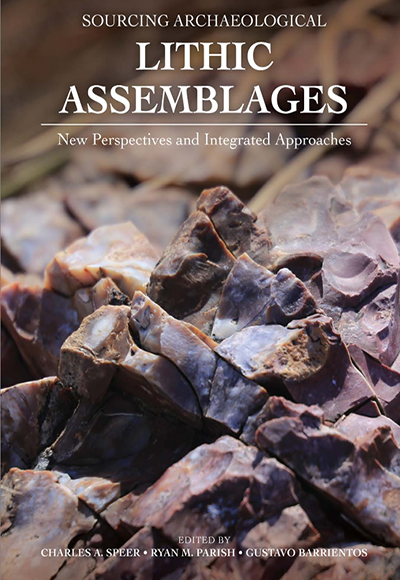 Ryan Parish, Associate Professor, Department of Earth Sciences
Ryan Parish, Associate Professor, Department of Earth Sciences
Sourcing Archaeological Lithic Assemblages
For most of our existence, humans have manipulated stone into tools that are essential
for survival. Generally resistant to degradation, stone tools comprise a large portion
of the material culture found at archaeological sites worldwide. Recovery of stone
tools during archaeological excavation indicates the location where they were discarded,
often tied to where they were used. “Sourcing” refers to attempts to determine the
origin of the raw materials used to produce these tools. Knowing the beginning and
end points of a tool’s use-life, as well as the likely paths it took between those
two locations, can offer insight into trade and procurement patterns. The scholars
gathered in this volume employ a variety of unique approaches to real-life contexts
in multiple geographic regions. These studies illustrate the numerous, robust options
available to archaeologists and researchers today, as well as the problems that must
be faced and resolved.
Part 1 of the book explores technological approaches to sourcing in conjunction with
innovative survey strategies. The chapters describe a particular method while often
offering suggestions for improving the chemical analysis. Part 2 focuses on region-specific
and methodological sourcing applications. In a concluding review, Michael D. Glascock
critiques each of the chapters and presents his views, developed across 40 years of
work in the field, on sourcing raw materials. Broadly, these contributions demonstrate
how knowledge of lithic sources, geologic processes, the nature of variation, and
regional availability can provide a more thorough understanding of past peoples.
 Beverly A. Tsacoyianis, Associate Professor, Department of History
Beverly A. Tsacoyianis, Associate Professor, Department of History
Disturbing Spirits
The concept of mental health treatment in war-torn Middle Eastern nations is painfully understudied. In Disturbing Spirits, Beverly A. Tsacoyianis blends social, cultural, and medical history research methods with approaches in disability and trauma studies to demonstrate that the history of mental illness in Syria and Lebanon since the 1890s is embedded in disparate―but not necessarily mutually exclusive―ideas about legitimate healing. Tsacoyianis examines the encounters between “Western” psychiatry and local practices and argues that the attempt to implement “modern” cosmopolitan biomedicine for the last 120 years has largely failed―in part because of political instability and political traumas and in part because of narrow definitions of modern medicine that excluded spirituality and locally meaningful cultural practices.
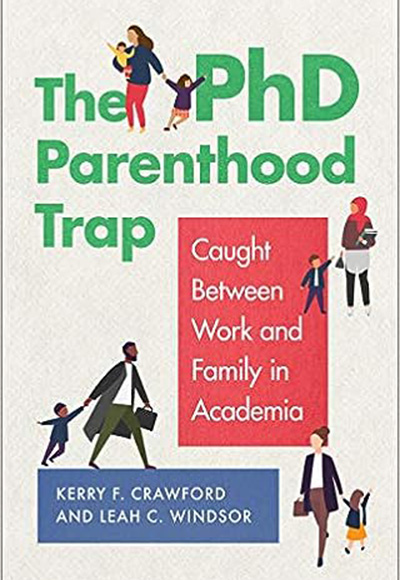 Leah Windsor
Leah Windsor
The PhD Parenthood Trap
Academia has a big problem. For many parents ― especially mothers ― the idea of "work-life
balance" is a work-life myth. Parents and caregivers work harder than ever to grow
and thrive in their careers while juggling the additional responsibilities that accompany
parenthood. Sudden disruptions and daily constraints such as breastfeeding, sick days
that keep children home from school, and the sleep deprivation that plagues the early
years of parenting threaten to derail careers. Some experience bias and harassment
related to pregnancy or parental leave. The result is an academic Chutes and Ladders,
where career advancement is nearly impossible for parents who lack access to formal
or informal support systems.
In The PhD Parenthood Trap, Kerry F. Crawford and Leah C. Windsor reveal the realities of raising kids, on or
off the tenure track, and suggest reforms to help support parents throughout their
careers. Insights from their original survey data and poignant vignettes from scholars
across disciplines make it clear that universities lack understanding, uniform policies,
and flexibility for family formation, hurting the career development of parent-scholars.
Each chapter includes recommendations for best practices and policy changes that will
help make academia an exemplar of progressive family-leave policies. Topics covered
include pregnancy, adoption, miscarriage and infant loss, postpartum depression, family
leave, breastfeeding, daily parenting challenges, the tenure clock, and more. The
book concludes with advice to new or soon-to-be parents to help them better navigate
parenthood in academia.
The PhD Parenthood Trap provides scholars, academic mentors, and university administrators with empirical
evidence and steps to break down personal and structural barriers between parenthood
and scholarly careers.
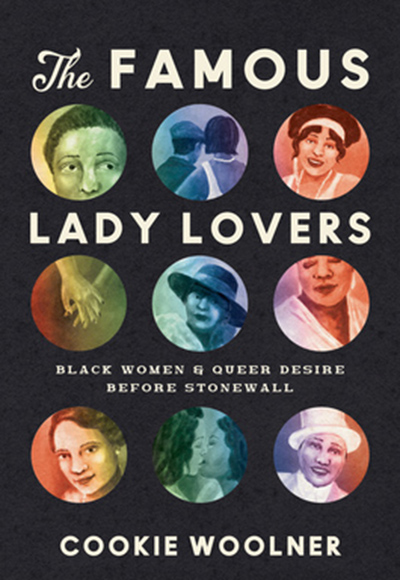 Cookie Woolner
Cookie Woolner
The Famous Lady Lovers
Black queer women have shaped American culture since long before the era of gay liberation.
Decades prior to the Stonewall Uprising, in the 1920s and 1930s, Black "lady lovers"—as
women who loved women were then called—crafted a queer world. In the cabarets, rent
parties, speakeasies, literary salons, and universities of the Jazz Age and Great
Depression, communities of Black lady lovers grew, and queer flirtations flourished.
Cookie Woolner here uncovers the intimate lives of performers, writers, and educators
such as Bessie Smith, Ethel Waters, Gladys Bentley, Alice Dunbar-Nelson, and Lucy
Diggs Slowe, along with the many everyday women she encountered in the archives.
Examining blues songs, Black newspapers, vice reports, memoirs, sexology case studies,
and more, Woolner illuminates the unconventional lives Black lady lovers formed to
suit their desires. In the urban North, as the Great Migration gave rise to increasingly
racially mixed cities, Black lady lovers fashioned and participated in emerging sexual
subcultures. During this time, Black queer women came to represent anxieties about
the deterioration of the heteronormative family. Negotiating shifting notions of sexuality
and respectability, Black lady lovers strategically established queer networks, built
careers, created families, and were vital cultural contributors to the US interwar
era.
